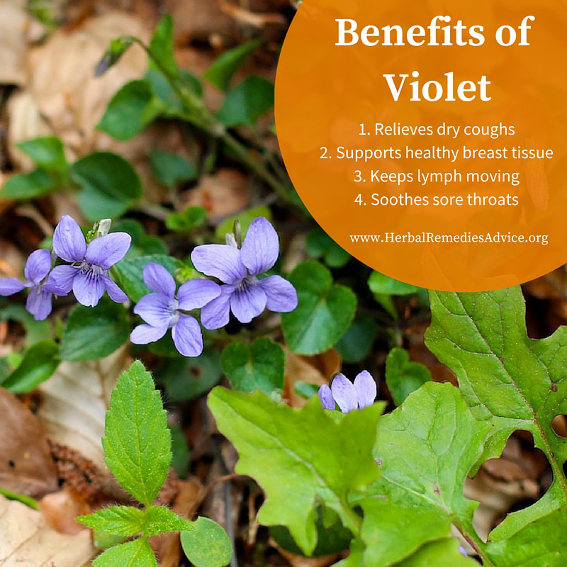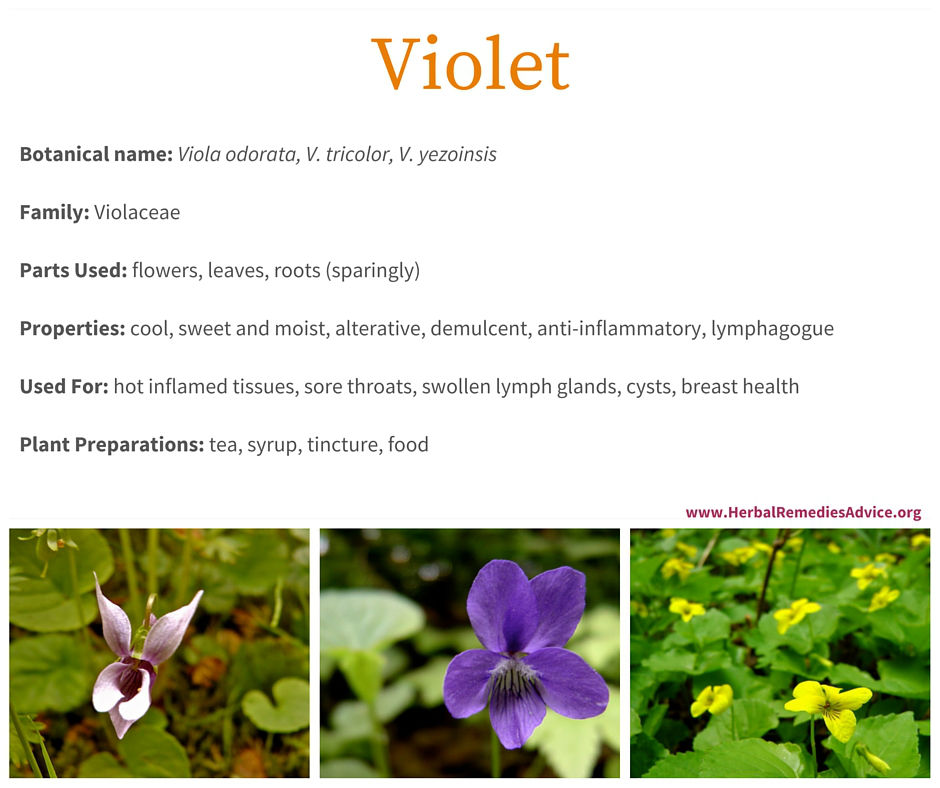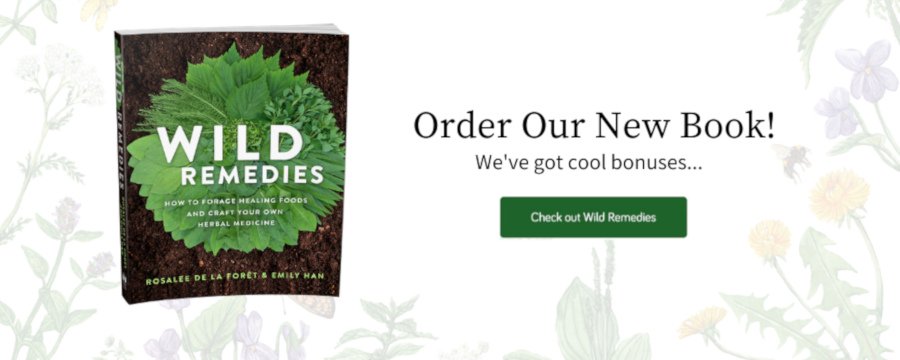Get weekly tips, recipes, and my Herbal Jumpstart e-course! Sign up for free today.

Violet Flower Benefits
Share this! |
|
My
first experience with violet was on a retreat with Paul Bergner. We
were hiking around the Mt. Hood area of Oregon when we came upon an open
meadow. Delighted, Paul dropped to the ground exploring the foliage.
All around him were plants with heart shaped leaves with small yellow
flowers. He gently pulled out a plant from the ground, wiped off the
mud, and began to nibble the roots. Because there was such an abundance
of plants in that area, Paul invited all the students to do the same.
I found a small plant and gingerly uprooted it. It tasted quite pleasant. Fresh, sweet, salty, and then... quite mucilaginous. (Before you eat lots of violet roots note that they are emetic in high doses.)
My first impression of violet was that it is a very delicate plant. It lays close to the ground, some small violet flowers looking up and some looking down. These violet flowers that you see in the springtime aren’t true flowers as they don’t produce seeds. Later in the year small nondescript violet flowers form underneath the leaves and fulfill the reproductive duties of a true flower. It is commonly said that violets flower in the spring for the sheer exuberance of doing so.
Don’t let violet’s delicate nature fool you, however. This plant is a powerful ally in disguise.
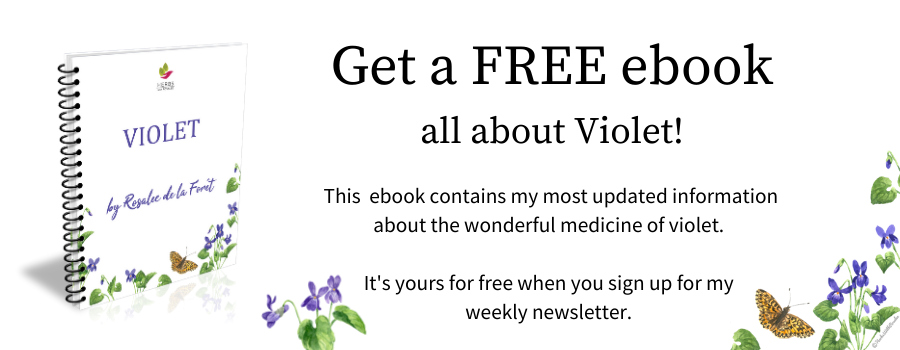
Violet Flower Benefits for Colds and the Flu
Violet flower is an important addition to your medicine chest during the cold and flu season. A syrup of the flowers can soothe an irritated and hot throat. It’s also a powerful lymphagogue that can relieve congestion and swollen lymph glands. Cooling and mucilaginous, violet can be used for a dry cough and for ear infections.
Violet Flower Benefits to Reduce Cysts
Violet’s most famous use is to dissolve cysts, lumps, and fibrotic tissue of the breast. Herbalist Matthew Wood recommends a fresh poultice of leaves and flowers for cancers of the lymphatic system, breasts, lungs, and skin. I’ve heard many stories of oil infused with fresh violets being used for dissolving lumps of the breast or simply as a preventive.
A fresh violet poultice can be used externally for a variety of reasons. Abscesses, acne, arthritis, minor skin irritations, sores, and swollen glands are just a few of the possibilities.
Violet Benefits as an Anti-Inflammatory
Violet eases pain. It is used externally and internally for pain associated with arthritis and is especially indicated for arthritis accompanied by dry hot tissues.
I often recommend violet leaf infusions for people who have dry, rough and itchy rashes (sometimes diagnosed as atopic dermatitis or eczema). Along with other recommendations, I've seen many people who have experienced this discomfort for years watch in wonder as it all disappears.
Violet for the Heart
Another name for violet is hearts-ease. It has been used for the physical and emotional heart for thousands of years. Violet is high in a constituent called rutin. Rutin strengthens capillaries, prevents platelet aggregation, and is anti-inflammatory.
Violet as Food
Violet is a culinary delight. Its fresh leaves make for a delicious salad. Violet flowers are edible and gorgeous, making them a nice garnish to any meal. Besides visual appeal, the flowers can be made into a variety of herbal goodies including syrups, candies, and jams.
Violets do more than taste good, they are also a nutritious addition to our diet. Violet flowers and leaves contain very high amounts of vitamin C - some say higher than any other plant. The leaves are also high in vitamin A.
"it stimulates waste and secretion, relieves nervous irritability, and improves nutrition" - John Scudder, Eclectic physician
Click here to watch my Wildcrafting Edible Violets video!
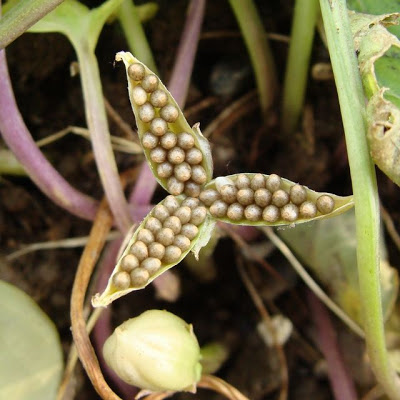 Violet Seeds
Violet SeedsBotanically Speaking
The official violet used in medicine is Viola odorata, but as far as I know all members of the Viola genus will work in a similar manner. Viola odorata originally comes from Europe and has naturalized across much of the United States. The North American continent also contains many native species of violets.
Violets belong to a family of their own called Violaceaea. According to Tom Elpel, author of Botany in a Day, there are 16 genera and 850 species in the Violoaceaea family. The African violet, which is often grown in pots here in the US, is not a member of the violet family.
Violets have irregular flowers with five separate petals.
The pansy is a cultivated violet whose flowers can be eaten as well.
Violets have an exploding seed valve.
You can easily grow cultivated violets like pansies in your garden. Wild violets grow abundantly in the northern hemisphere. Look for them in damp and shady meadows.
Violet offers many different ways to explore its gifts. If you have access to fresh violets, try making a syrup, infused oil, infused vinegar, and a poultice. Add the greens and violet flowers to salads or garnish any meal for a beautiful and wild flare.
If you aren’t able to find violets growing near you, you can order the dried violet leaf from Mountain Rose Herbs. Violet leaves make a great nourishing herbal infusion and can be used in this way for many of the benefits listed in this article.

Rosalee is an herbalist and author of the bestselling book Alchemy of Herbs: Transform Everyday Ingredients Into Foods & Remedies That Healand co-author of the bestselling book Wild Remedies: How to Forage Healing Foods and Craft Your Own Herbal Medicine. She's a registered herbalist with the American Herbalist Guild and has taught thousands of students through her online courses. Read about how Rosalee went from having a terminal illness to being a bestselling author in her full story here.
